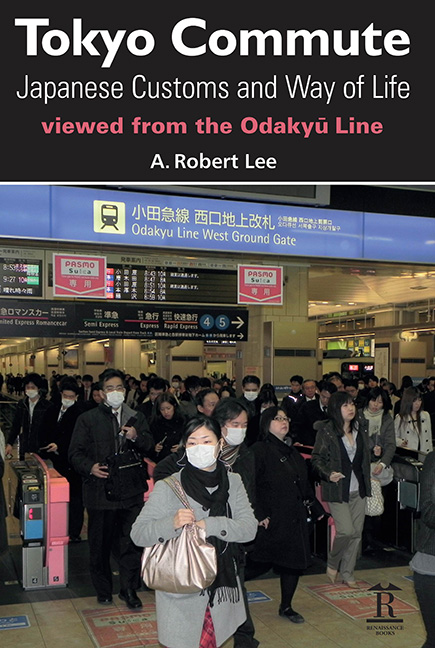Book contents
- Frontmatter
- Dedication
- Acknowledgements
- Contents
- 1 Odakyū-sen
- 2 Shinjuku Station
- 3 Shinjuku
- 4 Mukōgaoka-yūen North
- 5 Mukōgaoka-yūen South
- 6 Mukōgaoka-yūen Platform
- 7 January Monday
- 8 Odakyū Notables
- 9 Odakyū Line Sounds Familiar
- 10 Train Notices
- 11 Odakyū Commercials
- 12 February Tuesday
- 13 Odakyū Keitaispracht
- 14 By-line, Setagaya Line
- 15 March Wednesday
- 16 Odakyū Day-out Sendagi
- 17 Shimo-Kitazawa
- 18 Bicycle!
- 19 Odakyū Bike Interview – Toda-san
- 20 International Interlude via Narita Airport
- 21 Keitai Train Culture
- 22 April Thursday
- 23 Odakyū Tamagawa
- 24 Station Sights
- 25 Odakyū-sen, Yoyogi-Hachiman Eki
- 26 May Friday
- 27 Mukoōgaoka-yūen, Day for Night
- 28 Odakyū Day-out, Hakone
- 29 June Saturday
- 30 Odakyū Commercials
- 31 Odakyū Smokes
- 32 By-line, Nambu Line
- 33 Odakyū Bag Watch
- 34 Seijo Times
- 35 Odakyū Day-out, Yokohama
- 36 July Sunday
- 37 Odakyū Trains of Thought
- 38 Train Signs, Train Sounds
- 39 By-line, Tama Express
- 40 August Monday
- 41 Odakyū Day-out, Chiba
- 42 September Tuesday
- 43 Odakyū Lady-grooming
- 44 Odakyū and Near-Odakyū Women’s Hairday
- 45 Odakyū Evenings-out
- 46 October Wednesday
- 47 Odakyū Day-out, Ibaraki
- 48 Chikan! Odakyū Misbehaviour
- 49 November Thursday
- 50 Odakyū Blues
- 51 Odakyū Men’s Haircut
- 52 Odakyū Day-out, Ō-Sumo
- 53 December Friday
- 54 Odakyū Store
- 55 Odakyū Bookshelf
- 56 Last Train
- Glossary
28 - Odakyū Day-out, Hakone
Published online by Cambridge University Press: 26 May 2022
- Frontmatter
- Dedication
- Acknowledgements
- Contents
- 1 Odakyū-sen
- 2 Shinjuku Station
- 3 Shinjuku
- 4 Mukōgaoka-yūen North
- 5 Mukōgaoka-yūen South
- 6 Mukōgaoka-yūen Platform
- 7 January Monday
- 8 Odakyū Notables
- 9 Odakyū Line Sounds Familiar
- 10 Train Notices
- 11 Odakyū Commercials
- 12 February Tuesday
- 13 Odakyū Keitaispracht
- 14 By-line, Setagaya Line
- 15 March Wednesday
- 16 Odakyū Day-out Sendagi
- 17 Shimo-Kitazawa
- 18 Bicycle!
- 19 Odakyū Bike Interview – Toda-san
- 20 International Interlude via Narita Airport
- 21 Keitai Train Culture
- 22 April Thursday
- 23 Odakyū Tamagawa
- 24 Station Sights
- 25 Odakyū-sen, Yoyogi-Hachiman Eki
- 26 May Friday
- 27 Mukoōgaoka-yūen, Day for Night
- 28 Odakyū Day-out, Hakone
- 29 June Saturday
- 30 Odakyū Commercials
- 31 Odakyū Smokes
- 32 By-line, Nambu Line
- 33 Odakyū Bag Watch
- 34 Seijo Times
- 35 Odakyū Day-out, Yokohama
- 36 July Sunday
- 37 Odakyū Trains of Thought
- 38 Train Signs, Train Sounds
- 39 By-line, Tama Express
- 40 August Monday
- 41 Odakyū Day-out, Chiba
- 42 September Tuesday
- 43 Odakyū Lady-grooming
- 44 Odakyū and Near-Odakyū Women’s Hairday
- 45 Odakyū Evenings-out
- 46 October Wednesday
- 47 Odakyū Day-out, Ibaraki
- 48 Chikan! Odakyū Misbehaviour
- 49 November Thursday
- 50 Odakyū Blues
- 51 Odakyū Men’s Haircut
- 52 Odakyū Day-out, Ō-Sumo
- 53 December Friday
- 54 Odakyū Store
- 55 Odakyū Bookshelf
- 56 Last Train
- Glossary
Summary
HAKONE
National Park just over a train-hour due south of Tokyo. So, first, a morning Express from Mukōgaoka-yūen to Machida. And from there, with booked seats on the Odakyū Line's finest, it is the Romance Car all the way. Any one of these bullet-nosed beauties will do, each colour-coded, each logarithm’d so to speak – the 7000 (LSE), 10,000 (HiSE), 20,000 (RSE), 30,000 (EXE), 50,000 (VSE) or 60,000 (MSE). Presumably the 40,000 somehow went missing in action? As to Hakone itself it holds near-mythic properties for Tokyoites and the like, a kind of Japanese Lake District, local Dordogne or Yellowstone. You get there after maybe a sembei (rice-cracker) or two, an onigiri, and a swill of o-cha (green tea). Even an early eki-bento. And then it is Mother Nature. Tree-lined hills, greenery, challengingly clean air, valleys and groves. A spot of ex-volcano, or at least its impact, is to be had at Owakudani and other mountains-and-valleys. And if you are thinking of nights-over, then it is the ryokan (Japan's traditional inns with tatami-mat and futon room and exquisite dinner – kaisaki – and breakfast) and the infinite pleasures of the onsen (hot springs with the obligatory small towel for modesty purposes). Edo Japan. Vintage Japan.
HAKONE WEST
But we, this time, are headed for the Hakone Open Air Museum. From Hakone-Yumoto it is on to a red connector-train which does switchbacks to get you up into the mountains. Positively Swiss. Bird-life. Lakes. Sightseers. And then, after disembarkation at Chokoku-no-Mori, the museum itself. Spacious viewer pathways. Small Appian Ways of busts and profiles, both ground-level and aerial sculpture. Colours, materials, forms and compositions spread out against the sky. You cannot help but feel a touch oceanic, spatial. And in the company of some of the world's best. One centrepiece has to be the 300 Picassos, cubist and other canvases to fish-engraved plates, at the duly named Picasso Pavilion. Another is the world's most extensive Henry Moore collection, gloriously rounded figures in motion and at rest. But you are also in the company of Rodin and Miro and relative contemporaries like Marta Pan (Floating Sculpture, 1969) and Gabriel Loire (Symphonic Sculpture, 1975). It is the human hand set down amid Nature's hand. Lovely interplay. Open air interplay.
- Type
- Chapter
- Information
- Tokyo CommuteJapanese Customs and Way of Life Viewed from the Odakyū Line, pp. 111 - 114Publisher: Amsterdam University PressPrint publication year: 2011



